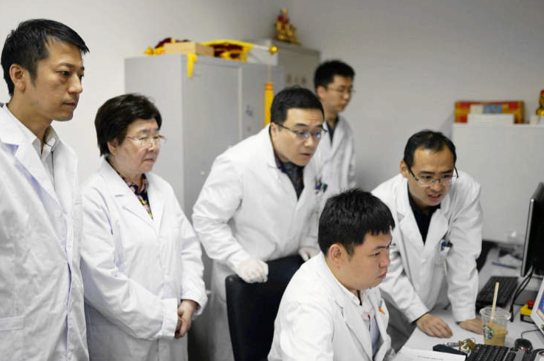- News
China-made "Magnetic Resonance guided phase-controled high intensive focused ultrasound system" Expected to Treat Parkinson's Disease: Shanghai Experts Completed the Preclinical Primate Animal Experiments for the First Time
打破国外垄断,国产“磁波刀”有望治疗这类帕金森!上海专家联手首次完成临床前灵长类动物实验
Non-invasive, controllable, and strong in penetration! The technology of "Magnetic Resonance guided phase-controled high intensive focused ultrasound system" is playing an increasingly important role in the treatment of essential tremor and tremor-dominant Parkinson's disease.
On April 27th, another breakthrough was achieved in the research and development of the domestically produced Magnetic Resonance guided phase-controled high intensive focused ultrasound system. The team led by Professor Wang Han, Deputy President of Shanghai General Hospital and academic leader of the Radiology department, joined forces with Professor Shen Guofeng's team, Professor Chen Yao's team from the School of Biomedical Engineering, Shanghai Jiao Tong University, and Green Medical Era Medical Technology Co., Ltd. to successfully complete the preclinical primate animal experiment for the treatment of essential tremor and tremor-dominant Parkinson's disease using the domestically produced Magnetic Resonance guided phase-controled high intensive focused ultrasound system. This experiment tested the safety, effectiveness, and stability of the system, providing important practical support for the Magnetic Resonance guided phase-controled high intensive focused ultrasound system to implement human clinical trials and ultimately achieve domestic production.

Essential tremor is a common neurological disease that significantly impacts patients' daily activities, including eating, drinking, writing, and more. Approximately 15% to 25% of patients are unable to lead a normal life or perform their jobs due to this condition.
Currently, surgical and pharmacological treatments for essential tremor are relatively mature. Among them, deep brain stimulation is an important minimally invasive interventional therapy. Through a minimally invasive surgical procedure, electrodes are implanted into the brain to stimulate neural nuclei and neural circuits, achieving the therapeutic goal. However, deep brain stimulation is ultimately an invasive treatment, and many patients have concerns about it.
The Magnetic Resonance guided phase-controled high intensive focused ultrasound system operates differently. Its principle involves the simultaneous emission of hundreds to thousands of ultrasonic beams under the guidance of real-time superconducting magnetic resonance imaging. Through real-time phase control, it achieves precise multi-mode focusing, and utilizes real-time magnetic resonance temperature monitoring to accurately ablate the treatment target in the brain. Patients can undergo Magnetic Resonance guided phase-controled high intensive focused ultrasound system surgical treatment in an outpatient setting, without the need for craniotomy or general anesthesia.
Professor Wang Han told reporter that the Shanghai General Hospital, in collaboration with Professor Shen Guofeng's team from the School of Biomedical Engineering, Shanghai Jiao Tong University, and Green Medical Era Medical Technology Co., Ltd., under the guidance of Academician Chen Yazhu, have jointly overcome key core technological challenges and successfully developed the noninvasive treatment technology of "Magnetic Resonance guided phase-controled high intensive focused ultrasound" with complete independent intellectual property rights. Additionally, they have also developed a domestic series of products that have entered clinical trials.
The principle of this technology is similar to phased array radar, allowing for active perception and flexible adjustment of the position of ultrasonic focal points, enabling rapid movement and switching of the focal points. During the treatment process, this system can non-invasively detect various parameters such as temperature, making the entire surgical operation visually accessible. Doctors can guide the surgical operation through real-time magnetic resonance images displayed on the backstage monitor screen, and evaluate the treatment effect in a real-time and precise manner, significantly improving the safety and effectiveness of focused ultrasound therapy.
In this animal experiment, the research team used rhesus monkeys, a species of primates, as experimental subjects to verify the system safety and effectiveness of the domestically produced device. It is reported that the first-generation domestically produced Magnetic Resonance guided phase-controled high intensive focused ultrasound system for the treatment of brain diseases will focus on thermal ablation therapy for essential tremor, tremor-dominant Parkinson's disease, and movement disorder-type Parkinson's disease after its launch.
